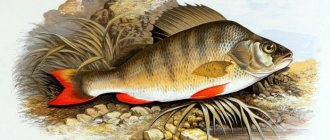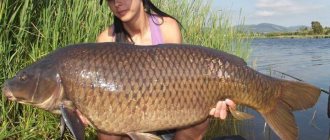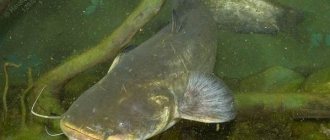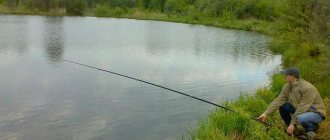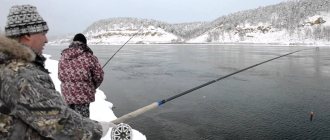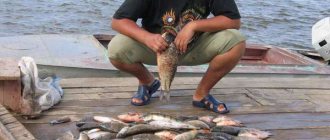- Wild animals
- >>
- Fish
Taimen (Hucho taimen) is a true river monster, also known as Siberian taimen, which can grow to sizes that seem incredible, almost the height of a person. Armed with strong rods and foot-long articulated streamers, fishermen in Mongolia or Russia can spend days searching for taimen ready to swallow their bait, but once the fish decides to pursue its prey, it does so with surprising speed and aggression. If the angler's skills are up to the task, he will be left with an unforgettable trophy for life. You can learn more about this amazing inhabitant of Russian rivers from this material.
Origin of the species and description
Photo: Taimen
Taimen, known as Siberian taimen and also as Siberian giant trout, is a unique species of fish in the salmon family. According to a study of the genotype of the fish, this is the oldest salmon fish, the age of which is estimated at 40 million years. Recently, data has appeared showing a closer relationship of taimen with the Pacific salmon Oncorhynchus, as well as the noble Pacific salmon belonging to the genus Parasalmo.
Video: Taimen
Extant salmonids have three lineages, considered as subfamilies:
- whitefish (Coregoninae);
- grayling (Thymallinae), including char;
- moose and trout (Salmoninae).
All three lineages are accepted to identify a set of derived characters that stand out as a monophyletic group. Salmonids first appear in fossils in the Middle Eocene. Fossils of Eosalmo driftwoodensis have been found in Driftwood Bay. This extinct genus shares traits found in the salmon, whitefish and grayling lineages. Based on this, E. driftwoodensis is an archaic salmon representative, demonstrating the most important stage in the evolution of salmonids.
Some of the species appear to belong to Oncorhynchus, the current genus of Pacific salmon and some species of trout. The presence of these species on land established that Oncorhynchus was not only present in the Pacific basins before the early Pliocene, but that these lineages diverged into other aquatic areas. The split between Oncorhynchus and Salmo (Atlantic salmon) occurred long before the Pliocene. Most likely in the early Miocene.
Kinds
This family includes several outwardly similar species of fish:
- common taimen;
- Sakhalin taimen;
- Danube salmon;
- Mongolian taimen;
- Korean taimen;
- Sichuan taimen and other lesser-known species.
Let's look at some of them in more detail.
Ordinary
The most common species of this genus. Inhabits clean and mountain rivers, as well as clear lakes of the Urals, Far East, Yakutia, Khakassia and other regions. In addition, it is common in the reservoirs of Mongolia. In addition to its distribution area, this species also has the largest size, not only among representatives of its genus, but also among the entire salmon family. Common taimen grows up to one and a half to two meters in length and up to 60 or more kilograms of weight. There is an opinion that the largest fish reach a weight of up to one hundred kilograms, but no documented cases have been recorded.

The dimensions of trophy taimen are very large. If in most regions of the Russian Federation a pike weighing 10 kilograms is considered a serious trophy, then taimen weighing 10 kilograms is a completely average specimen, caught in almost every fifth bite.
Due to population decline, the common taimen is currently included in the Red Book of the Irkutsk region and other constituent entities of the Russian Federation.
Appearance and features
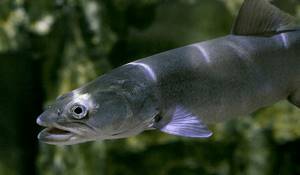
Photo: What taimen looks like
Taimen have small cross-shaped dark spots on the head and sides of the body. The upper jaw extends back beyond the posterior edge of the eyes. The scales are oval, small, without radial grooves or rings, and extremely distinct. The adipose fin is well developed.
The species differs from other salmon species in central and eastern Europe by a combination of the following characters:
- the teeth represent a continuous stripe in the shape of a horseshoe;
- small round dark spots on the head and dark X-shaped or crescent-shaped spots on the body;
- the head is long and dorsally flattened;
- very long jaws;
- in adults, the upper jaw reaches the posterior edge of the eye;
- shallow cylindrical body;
- caudal caudal region, deeply prominent and reddish in adults;
- there are 9-18 gill slits, usually 11-13.
Coloration varies geographically, but is usually olive green on the head, fading to reddish brown on the tail. The adipose, anal and caudal fins are often dark red. The belly varies from almost white to dark gray. Taimen appears to be the largest salmon in the world, being heavier at average and maximum size than the largest North American salmon. Most adult fish caught weigh between 15 and 30 kg. The average length is from 70 to 120 cm.
The maximum size is not guaranteed, but a fish caught on the Kotui River in Russia in 1943 is believed to have been 210 cm long and weighed 105 kg, which is the largest size recorded. The maximum length of individuals is from 150 to 180 cm. The World Fish Association recorded a world record of 41.95 kg with a length of 156 cm. To reach such sizes, the fish needs to grow for at least fifty years.
Taimen of the Dadva River. Part 1
01/08/2019 Alexey Shanin (154 articles)
share
Facebook Twitter Google+ LinkedIn Pinterest
Taimen is the most ferocious and one of the largest predators in fresh water bodies in Russia. Every spinning angler, without a doubt, wants to feel the power of resistance of this fish at least once. Personally, from early childhood I had a dream of catching taimen; my grandfather, a native Siberian, talked about the huge taimen that men caught in the waters of the Yenisei. The first opportunity to make my dream come true was in 2015, when I made my first expedition to one of the rivers of the Primorsky Territory. That time, the trip took place after another typhoon, which brought huge amounts of precipitation, bringing it down on the sources of the river. The water level was more than a meter higher than the usual summer level, and transparency left much to be desired. Nevertheless, my acquaintance with taimen took place, although I managed to catch small fish weighing only up to 4 kg. But the very next year I returned here under normal weather conditions and the fishing was at its best! This time the largest taimen already weighed 15 kilograms and it was, at the level of my feelings, a great success. Of course, the fish is big, but you always want more.
I was told a lot about the rivers of the Khabarovsk Territory as the richest in trophy taimen. Having received my first experience of catching this mighty fish, I had a sporting desire to catch taimen weighing more than twenty kilograms. On the rivers of Primorye and central Siberia this is a very difficult task - pressure greatly affects the size of the fish. Therefore, I began to look for opportunities to get to a good river in the Khabarovsk Territory. My friends, spinning fishermen from Khabarovsk and Vladivostok, helped in this matter by suggesting contacts of people organizing taimen expeditions. I was offered several options to choose from, which differed in the method of delivery, and, accordingly, in the budget: by river or by air. I chose the cheaper option; I’m not ready to pay several hundred thousand rubles for a helicopter. The time chosen was one of the best - the last week of September. At this time, taimen is very active, and nature is filled with the bright colors of golden autumn.
The river with the code name Dadva (I was very much asked not to publish the real name) greeted us with beautiful sunny weather.
Guides Andrey and Dmitry immediately tried to catch pike in the lower reaches of the river. The toothy one here is noticeably different in appearance from the one I’m used to - it’s an Amur pike. It has a different color: dark spots on a light body, whereas the common pike has light spots on a dark body. The guides dropped us off on a rocky spit, behind which there was a shallow bay. I took two spinning rods out of the tube: one for me, the second for the operator who wanted to catch fish before we started work. I equipped the rods with reels and baits and ran to catch pike, of which there were a lot here. I installed the DUO Realis Fangbait 120F-SR wobbler, which showed itself very well both for pike here in the European part of Russia, and here in the Far East for taimen.
The pike were biting like a machine gun!
Only the size is not large: 1-2.5 kg.
On this trip, my number one goal is to catch taimen “twenty”, and my second goal is to catch a trophy-sized Amur pike. While I was practicing catching pike, Vadim decided not to disturb me and walked along the spit upstream. There, twice, with noise and splashes, some fish hit the fry on the surface. The guide Dima said that, most likely, it was a large pike, to which Vadim replied: “We’ll check!” He threw a Pontoon21 Cablista 125SP wobbler into the splash area and, as soon as he started retrieving, he hooked the hook with the exclamation: “Yes!”
The fish, judging by the resistance, is not small. Until the last moment I was sure that it was a pike. However, when Vadim brought the fish to the shore, the red tail of the taimen appeared from the water.
This is not Vadim Grushko’s first taimen; a year ago in Primorye he caught a taimen of approximately the same size.
Rise day. Our guides know the river very well in detail. Of course, like any mountain river, Dadva regularly changes its course after floods. However, the most basic points may remain unchanged for several years. Dmitry brought us to one of these places early in the morning.
The place is a shallow wide riffle, turning into a local hole with a whirlpool. Based on my vast experience of trout fishing in mountain rivers, I rated this place a five plus. Why this comparison? Perhaps there is not much difference between taimen and trout in the selection of promising hunting areas. These fish occupy feeding positions where they can obtain the maximum amount of food with the least amount of effort. The main difference is only in scale. But it doesn’t matter here whether it’s a small river or a river with a large watercourse, because the laws of hydrology are the same in both cases. Therefore, any river can be read using virtually the same pattern, with adjustments for the scale and feeding preferences of a particular predator.
The current here is strong, so you need a bait with good hydrodynamics. In my arsenal there is no wobbler more suitable for such conditions than the DUO Realis Fangbait 120F-SR. At its core, this minnow is a logical continuation of the very popular DUO Spearhead Ryuki series of wobblers for catching brook trout in mountain rivers, but in a much larger design. Both the behavior and stability in strong currents of Fangbait and Ryuki are identical, only they are designed for catching fish in different weight categories.
By the way, taimen is a fish that can bend and “tie in a knot” almost any hooks. For this reason, anglers aiming to catch serious taimen immediately change the tees and, often, winding rings to more powerful ones on all new baits. So Fangbait in this regard is an exception to the rule: the original very powerful hooks do not require replacement, they are simply perfect!
On the very first retrieve there is a bite - yes! I fish for it, but the fish on the hooks are very small.
This is taimen. As it turned out later, it was the smallest of all the days of fishing!
I release the child and continue fishing the point.
After a few runs, when I ran the wobbler along the stream, a very powerful bite happened in the style of “give back the spinning rod” - yes! I felt heaviness, real heaviness!
Following Dmitry’s recommendation, I duplicate the hook, loosen the clutch on the reel by half a turn and carefully begin fishing. However, this taimen was not destined to look into the soul: the fish began to tremble with its head in the water column and walked away... It's a shame! I unwind the wobbler and inspect the bait – the teeth left very wide, deep marks, pike don’t leave such marks. The hooks are fine. During the fishing process, the thought flashed that the 28Lb (#1.5PE) cord with such a load was working at the limit of its strength and should be replaced with a more powerful 44Lb (2.5PE). Having decided to do this at the next fishing spot, I did not suspect that I had made a fatal decision. On one of the retrieves, right here, along the main stream, another heavy bite occurs... There is a hook!
At first, the fish behaves pliantly and seems to have everything under control. Standing knee-deep in the water and slowly moving towards the shore, I bring the fish closer and closer. This is a large taimen that has not yet shown its temper, so I am attentive. The premonition did not deceive: sensing that an unknown force was pulling it into the shallow water, the taimen turned downstream and, in a sprint jerk, reeled out at least 70 meters of line from the reel! It was impossible to stop him: big, heavy, very powerful! It's a shame, but it all ended in a cliff.
Fangbait became a “piercing” on the face of this giant. Dmitry estimated the fish at 25+ kg. You always need to listen to your inner voice, since it said: “Change the cord,” then that’s what you need to do! And then, in excitement, I hoped that nothing like this would happen and was deeply mistaken, losing the trophy, the bait and, possibly, the chance of biting such a giant. A lesson for the future... Immediately I take out a skein of new Pontoon21 Eigheria 44lb braid and wind it, such a “rope” will clearly withstand such loads with a reserve.
There were no more bites in this place and we swam up the river.
The next place was a vast shallow water with a moderate current. Dmitry Briefly explained the peculiarity of fishing here: taimen can stand anywhere, even in places with a depth of 40-50 cm! Here he hunts, and therefore is active and reacts to bait without hesitation.
I go into the water, make a cast to the far shore, the wiring is there! And, almost immediately, the gathering... Well, how can that be?! Why? Third bite and past the cash register! I inspect the tees again, check the sharpness - everything is in order. I continue to systematically fish the place, but no one is interested in the wobbler anymore. When he was about to leave, Dmitry said: “Three more casts!” I nodded in response, turned around, fired Fangbait under the far bank and, right there, spotted taimen!
I fish carefully, with an eye on previous gatherings. But the fish does not resist as violently as the previous giant, as if knowing that it will be released.
Now the taimen are near the shore in shallow water. I secure it by the tail - the first trophy is taken!
We weigh – 13 kg 040 g. Not a record yet, but a very nice fish!
I release the handsome man into the wild, after which Dmitry recommends making a few more casts in the same place. Taimen often live collectively, therefore, having caught one, you should count on catching one or even several more.
Dmitry was right again; almost immediately he pecked another taimen, albeit of a much smaller size.
As they say, the premises have been cleared. There were no more bites and we went further up. At one of the nice places, Dmitry stuck to the shore and said: “Three casts” and we move on.
To get a bite, three casts were not required - the fish bit immediately, as soon as the wobbler hit the water. This time it is Amur pike. Incredibly beautiful fish!
Autumn days are short, so we don’t stagnate at points.
I liked the next place visually more than all the previous ones. This is the exit from the reach onto the roll with expansion. On the mountain rivers of the Caucasus, such places are the surest position for catching large brook trout. So the taimen, according to Dmitry, chooses just such places. Here I catch another representative of the Amur salmon - the sharp-snouted lenok.
Our second guide, Andrey, while we were fishing on the main channel, decided to run to the channel nearby to check if there was lenok. But, on the very first retrieve, I caught a large pike there.
She pulled 9 kg! Now my eyes have lit up to catch such a “Amur fish”, because taimen is taimen, and I really love pike! But this is further, the guys said that there will be gorgeous pike bays higher up. In the meantime, you need to fully fish the exit from the reach.
I resisted, feeling that he was here. In terms of depth, the Realis Fangbait 120F-SR is ideal for this place: along the entire wiring from the far shore, the wobbler periodically catches bottom stones with its blade, thereby posing as a very easy victim. The current is strong, so the retrieval was carried out mainly in an arc while holding the bait with almost no forward retrieving. It was at the moment of demolition of the wobbler, when its blade was catching the bottom soil, that an unexpected but long-awaited bite occurred.
I had to tinker with this fish quite a bit: the taimen actively took advantage of the strong current, trying to merge with the current into a riffle, from where it would be extremely difficult to get it. In such a situation, composure is required: tighten the clutch a little tighter (a distance of 40-50 meters allows the cord to absorb a little) and stand still like a pillar! The fish will get tired and, according to the law of physics, it will begin to be pushed towards the shore, where dealing with it is a matter of technology. It is for such situations that you need a decent reserve of power in the tackle, otherwise you won’t be able to hold such a fish.
I did everything right and ten minutes later I was posing in front of the camera with a 12-kilogram taimen in my hands.
A photo shoot should always be quick. I never take taimen to the shore, where it can break free and fall on the rocks: release and release occur at shallow depths. This is the easiest way to return the fish without causing significant injury to it.
Having released the “torpedo”, I continued to fish the drain. I stood here for another half hour, but, alas, to no avail. Let's move on.
At the time of the start of this fishing, my personal record for taimen, set in the Primorsky Territory, was 15 kg 020 g. In the morning there was a great chance to improve it, but, alas, I myself am to blame for this failure... However, there are a lot of places ahead that could potentially provide an opportunity to exceed the record weight many times over.
In the new place there are many new circumstances in the form of scattered snags, which is potentially the “grave” of my wobblers. The advantage is that most of them are visible in shallow water. In such places, you should not rush to cast; first, you should visually identify promising areas and take into account the location of the branches. Any predator loves snags and taimen is no exception.
The place looks very tasty, there is definitely an “owner” here!
Two empty wires... Didn’t catch any snags or taimen. I made the third cast with an adjustment a little further downstream, risking getting caught, and as soon as the wobbler fell on the water, my hands felt a greedy powerful tug - there it is!
It was not difficult to cope with this fish - just a little more than 9 kg... Baby...
I let go, throw and... Dead hook! Wobbler is a pity!
Of course, there is a supply, but you need to fight to the end for the safety of each bait, because there are still many days ahead and there are no stores with wobblers within a radius of at least 500 km. Therefore, we start the engine, swim to the place of the hook and try to free the powerful hooks from the wood.
The bait was saved, the fish was scared away and we sailed on to set up camp for the night. I received a lot of emotions during the day, I need to reboot my brain and go into battle tomorrow with new strength!
To be continued…
Alexey Shanin
Master of Sports of international class in sport fishing. Winner of twenty world championship medals, nine of which are gold. Five-time champion of Russia. Author of thematic documentaries about spinning fishing and publications in national and international periodicals.
Where does taimen live?
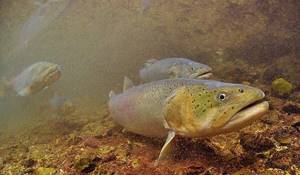
Photo: Taimen in Russia
Siberian taimen are found in Europe and Asia, including parts of the Caspian and Arctic basins in Eurasia (Volga, Ural, Pechora, Yenisei, Lena) and parts of the Pacific basin in Mongolia, Russia and China. The western border of their natural range is the upper reaches of the Volga and Pechora rivers. This species is found in a number of tributaries of the Pechora, including the Ilych, Kosiu, Bolshaya Sinaya and Usa. Over the past 20 years, there have been no records of the presence of this fish in the Komi Republic. The last recorded catch of the species in the Komi Republic was in the Ilych River in 1978.
Most of the range within the Volga and Urals (including a tributary of the Malyi Ik River) was lost. The only place in Europe where this species is still present is the Kama River (especially the Vishera River), where fishing is still limited. Taimen is also present in the Yayva River, and there are also records in the Kosva, Chusovaya and Berezovaya rivers. The species was observed in 1987 in the Udmurt Republic, in the Shiva River and in the lower reaches of the Votkono Reservoir. It is found in the Khabarovsk Territory, including the Amur River and its tributaries, as well as the Tugur and Uda rivers along the coast of the Sea of Okhotsk.
This species was sometimes caught in the Langry River in the north of Sakhalin Island. In Mongolia, taimen is found in the rivers Shishkhed, Eg, Uur, Delger Moron, Ider, Chuluud, Ero, Selenga, Orkhon and Tuul, as well as in the Darkkhad valley (Arctic basin) and Onon, the upper reaches of the Kherlen and Khalkhin rivers (Amur drainage). In China, this occurs in the Heilongjiang (Amur) River and its tributaries, as well as in the upper reaches of the Irtysh River in the Altai Territory in Xinjiang Province.
Now you know where taimen are found. Let's see what this fish eats.
What kind of fish is taimen?
The genus-forming taxa is the Siberian or common taimen (Hucho taimen), which is also known by the common nicknames “krasulya”, “laziness”, “talmen”. It is characterized by the largest dimensions among all salmon and the complete absence of the hypoosmotic mechanism necessary for a safe stay at sea. In addition to the ordinary one, experts distinguish Korean (Ishikawae), Sichuan (Bleekeri) and Mityagin forms. Another famous representative of the genus is the Danube salmon (Hucho hucho).
The species is one of the largest freshwater predators and, under optimal conditions, can live for more than 60 years. In standard catches, young 6-7 year old individuals (55-70 cm) weighing 3.5-5 kg prevail. Adult fish grow faster; meter-long ten-year-olds have a mass of 12 kg. At 20 years of age, the length of the predator is 120-125 cm (25-30 kg). But these figures are far from the maximum - the largest taimen weighed 105 kg with a height of 210 cm (1943, Kotui River, Krasnoyarsk Territory).
Appearance description
The slender and elongated shape of the body has much in common with the structure of trout and has ideal streamlining parameters that contribute to rapid movement in the water. Other features of the appearance of taimen include:
- fins shifted towards the tail;
- large flattened head;
- small scales (140-150 in the lateral line);
- a huge terminal mouth with sharp teeth curved inward (two rows);
- 11-13 gill rakers;
- dark gray (dorsal), light ash (ventral, pectoral) and red (anal, caudal) fins.
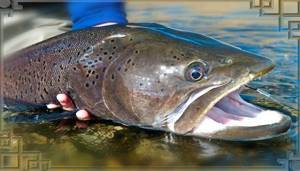
The permanent color of the Krasula is represented by a greenish or brownish ridge and silvery sides with black spots. During spawning, the body turns copper, orange or red. Immature young animals are characterized by the presence of dark transverse stripes.
Where is the taimen fish found?
In Russia, the main range is represented by rivers, tributaries and cold-water lakes of Central, Western, Eastern Siberia and the basins of the Laptev, Okhotsk, Japanese and Kara seas. Taimen lives in the Lena, Yenisei, Angara, and Oka. It is found in the Urals (Kama, Pechora), Khakassia (Abakan), Altai Territory (Biya, Katun), in the Far East and Transbaikalia (Amur, Tunguska, Yana, Shilka, Vitim, Onon). Krasulya does not bypass Sakhalin (Langry, Bolshoy Chingai, Pogibi, Noyida), it is found in the rivers of the Primorsky Territory that flow into the marginal waters of the Pacific Ocean (Margaritovka, Milogradovka, Avvakumovka).
What does taimen eat?
Photo: Taimen in the water
Adults are often found within their own territory (deep holes under rapids and waterfalls, confluences of small tributaries, below a bridge pillar or large rocks, coastal excavations), which they abandon only when foraging and spawning. Juveniles do not have a permanent territory. They are found in fast-flowing waters, hunting drifting invertebrates and switching entirely to a diet of fish 1-3 years after birth.
During the spawning period, taimen practically do not feed. After this, the period of gluttony begins, at this time the fish eats especially actively, but the period of gluttony does not last long and is replaced by passivity after the onset of summer heat. Then again the fish enters a period of zhora, associated with the taimen’s need to stock up on nutrients for the winter. The presence of a fatty layer helps the fish survive the scarcity of food supply during cold weather. Adult taimen are primarily piscivores, although they often feed on terrestrial prey such as rodents and birds.
Siberian taimen are apex predators in most systems where they are found, feeding on:
- fish;
- rodents;
- waterfowl;
- even bats.
Juveniles feed on invertebrates and caddisfly larvae. Depending on the reservoir, the basis of the diet consists of small fish of the families: whitefish, carp, grayling, etc. Gradually, young fish begin to hunt for fry of other fish, and by the end of the third year they switch to a full diet. Taimen can easily eat young relatives. Hungry fish attack frogs, chicks, squirrels, and mice.
Nutrition and lifestyle
Taimen prefers to hunt at dusk. If the day is rainy, sunny, remains active from morning to evening. It feeds on other fish (the diet includes whitefish, grayling, lenok, gudgeon, roach, perch), amphibians, small mammals, and waterfowl. Cases of attacks on dogs and foxes entering the water have been recorded. The fish is voracious and indiscriminate in its food, which is why it received the name “river tiger”.
Young individuals eat insect larvae, fry of other species, worms, leeches, and small crustaceans. Representatives of the ichthyofauna appear on the “menu” of taimen when it reaches the age of 3-4 years. At this age, the predator refuses to eat zooplankton.
Features of character and lifestyle
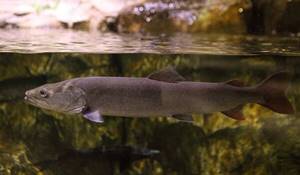
Photo: Taimen fish
Siberian taimen live exclusively in fresh water, mainly in fast rivers and streams. These fish are known to be found at altitudes above 1500 m and in coastal rivers near sea level. Taimen is a long-liver. It is a relatively slow growing species and late maturing. The fish grows to over 2 m and can live up to 30 years.
Generation time is estimated to be approximately 17 years for a population experiencing only natural mortality (i.e., no commercial harvest). This may be an underestimate because maternal effects or increased egg size as the female grows are not taken into account. The habitat of this species can be quite extensive, up to 93 km.
Interesting fact: In the summer, taimen are caught with a spinning rod using spinners, artificial mice, jig heads; in winter, a “swinger” with winter spinners is preferred. Taimen, like all salmon, has non-bony tender meat, quite fatty, with a pale pink tint.
Taimen spend their entire lives in fast-moving rivers with high oxygen levels, and they often actively move up and downstream. Spawning usually occurs in late May or June, depending on water temperature. The fish move upstream to smaller tributaries where they lay eggs and then return to larger rivers.
The largest taimen
Data on the size of the largest fish caught in this genus vary. In general, it is believed that 60 kilograms is the maximum recorded weight of taimen. However, there are documentary sources indicating that in 1943, in the Kotui River in the Krasnoyarsk Territory, a specimen with a length of 2 meters and 10 centimeters and a mass of 105 kilograms was caught using a net. If this information, which was reported by one of the state fisheries inspectors of Evenkia, is reliable, then today this taimen is the largest specimen caught.
Also in Altai, in the mountains, there is a lake called Kanas, in which there are very large specimens of taimen, the game of which from time to time is captured by camera lenses. Locals call this fish taimen-huguai. Judging by its external data, it is quite possible that among them the specimens are even larger than the current record holder, but they have not yet been caught, at least officially, so the Krasnoyarsk centner giant can be considered the largest fish of this genus caught to date.
Social structure and reproduction
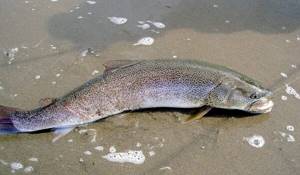
Photo: Big taimen
Taimen reach sexual maturity at approximately 5–7 years with a size of 60–70 cm and a weight of 2–3 kg. Females produce 4,000–30,000 eggs, depending on the size of the fish. In the Yenisei River, spawning usually occurs in May and June. In the Eg-Uur River basin in northern Mongolia, spawning occurs in May. The fish breed in shallow, fast-flowing areas on pebbly bottoms immediately downstream of large, deep river basins, often in small tributary rivers. They usually migrate upstream to spawn in the upper reaches of tributaries.
Interesting fact: Although some sources believe that the species' lifespan is 30 years, others claim that taimen can live for half a century or more. Due to where they live and the relatively small number of fish in a given area, this species has not been studied extensively, which explains some of the differences in the "facts of life". Adult fish tend to be solitary, which increases the difficulty of observation.
Taimen can overcome fairly high obstacles when migrating to spawning areas. The eggs are 5-6 mm in diameter and hatch in 28-38 days. The eggs remain in the gravel until the yolk sac is absorbed after 10-15 days, the juveniles first remaining near the spawning site and then moving downstream. Large immature individuals aged 2 to 4 years live in the same places as adults, but separately in smaller holes.
Fishing for taimen
The optimal time for fishing for salmon is May-June (post-spawning feast) or the period from late August to November (autumn feeding). The highest frequency of bites is observed in the morning and evening twilight, when fog falls on the water surface. The fish prefers to stick to the bottom layers of rivers and lakes, so they are less likely to grab bait from the surface or in mid-water. The predator's favorite stopping places are areas near rifts and rock ridges, dumps, mouths of tributaries and streams, and small islands on reaches.
To learn more:
Ruff: spiny perch fish
Spinning fishing
It is better to refuse ultralight and light forms, which will not be able to cope with the large mass and strong jerks of the redfish - when fishing, the prey often “lights a candle”, jumping high out of the water. A rod 2.2-3.0 m long with a top weight of 50-60 g is optimal. When catching taimen, spinning rods Aiko SGP, Daiwa Whisker, Hearty Rise SYLPHY have proven themselves well. When choosing a reel, it is better to give preference to spinning or multiplier traction models with a drag load of 7-10 kg and a spool capacity of 4000 or more according to the Shimano classification. The main thread is a braided cord with a cross-section of 0.23-0.3 mm with a breaking load of 12-40 kg. To avoid accelerated abrasion of the vein on stones, you can use a fluorocarbon shock leader. The main wiring is slow.
Lures for taimen
Due to the natural caution of the predator, you should use oscillating or rotating spoons of natural colors, which are characteristic of local fish (silver, copper, brass, gold), and have a set of different-sized baits. Large taimen fish well for small Mepps Lusox or Abu Garcia Toby, but completely ignore their larger counterparts. Good results are demonstrated by sinking and diving wobblers (suspenders) and Devons with spinning blades. Steadily floating fish-shaped baits (poppers) are used extremely rarely due to their low efficiency. It is much better to catch taimen using an artificial mouse 10-12 cm long, which realistically imitates a rodent floundering in the water. Such a spoon with several tees is especially effective when catching a predator on a cloudy day or at night.
Natural enemies of taimen
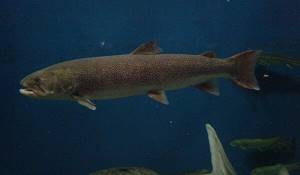
Photo: Sakhalin taimen
Taimen is at the top of the food chain, so it has virtually no natural predators, especially in adulthood. Young individuals are preyed on by other predatory fish, as well as some of their relatives. When taimen goes to spawn and travels vast distances, it can end up in the paws of a bear. The clubfoot inhabitants of the taiga are practically the main natural enemies of fish. However, the main enemy of taimen is humans, who cause irreparable damage to fish populations.
Interesting fact: Taimen faces a variety of threats, including pollution, sedimentation and erosion, mining, dam construction, road construction, illegal fishing, fisheries and climate change.
The National Geographic Society has established a special document that includes more than twenty at-risk species of threatened freshwater fish around the world. Taimen is included in this group. This project covers special species that make up a group known as "megafish". These are those species that grow over 180 cm or 100 kg in weight. More than seventy percent of these species are critically endangered as a result of pollution, poor resource management, and habitat loss.
Taimen is the only fish in the group belonging to the trout or salmon genus that grows large enough to become a respected member of this elite group. In China, taimen have already been caught to the point of extinction. In Russia the species is also classified as “highly at risk”. With the advent of recreational fishing tourism, which is mainly developed by Western travelers and adventurers, taimen poaching is on the rise.
Description of the fish
A giant beautiful fish of our Siberian rivers, with a bright red tail, the common taimen. This is a predator that reaches large sizes. Despite belonging to the salmon family, it resembles some kind of transitional species between salmon and whitefish.
Its maximum weight reaches sixty kilograms, and sometimes more. Having such a large size, adult fish have practically no external enemies other than humans. Indeed, by the age of 10, the taimen fish looks like a real giant, in comparison with its river counterparts. It is interesting to imagine the size of the largest taimen in the world. Although no one can say this for sure, there is still some data:
- it is known from the scientific literature that in the winter of 1945 in the Amur River, a trophy weighing about 80 kg was caught on ice tackle;
- a certain geologist Tolchevnikov saw in 1952 how an even larger one was caught in a net - 86 kg!
Nowadays, the capture of such giants is unheard of. Perhaps the number of this species has greatly decreased due to the pollution of many rivers.
The body of the predator is silver in color, with chaotically scattered black spots and a bright red tail. However, body color can change shades during the spawning period.
In recent years, taimen is classified as a small fish and is listed in the Red Book of Russia; its fishing is prohibited. Fishing tourism along Siberian rivers provides for a catch-and-release rule regarding taimen.
Recommended reading: How weather affects fishing
Because of its tasty meat, fishing for this fish was carried out too intensively, which led to its mass extermination. Now taimen has become rare in water bodies and if measures are not taken to restore it, it may cease to exist altogether.
Population and species status
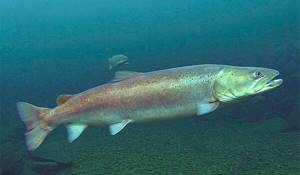
Photo: What taimen looks like
Throughout its range, taimen suffer from habitat loss, declining water quality, overgrazing, weed infestation, and poaching. Because these fish grow slowly—they take up to seven years to reach sexual maturity—populations cannot bounce back very quickly, which is why taimen are listed as “vulnerable” on the Red List maintained by the International Union for Conservation of Nature. According to their research, the taimen population has declined by 50-95%, depending on location, with the worst losses in China and the most stable populations in Russian Arctic basins.
Mongolia has been the most progressive in its conservation efforts, implementing catch and release regulations on all rivers and working with local residents to raise awareness of how important a healthy taimen population can be to the local economy. However, most of the species' historical range is contained in the Russian Federation (83.8% of the total). The historical, natural range of the species extends to China (6.4% of the total), Kazakhstan (6.1% of the total) and Mongolia (3.7% of the total).
Interesting fact: Population loss for individual regions varies from 3.2% within Russia (in the Volga, Urals and Pechora), 6.9% in China (in the Amur River basin) and 19.1% in Mongolia.
The loss of range is likely much greater given that many populations, particularly along the southern part of their distribution, have become significantly more fragmented as a result of local impacts from changes in land use and fishing pressure. However, there is currently insufficient data to provide reliable estimates for this species across much of its native range.

